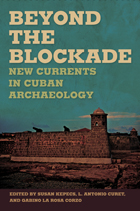
An important collection of essays and scholarship by Cuban archaeologists about precontact human settlement on the island.
An important and timely collection of essays that greatly expands knowledge of the human settlement of Cuba and the activities of its indigenous peoples. The collection is a testament to the tenacity of Cuban and US scholars determined to dismantle the political and economic barriers that have impeded collaborative archaeological scholarship in Cuba. Despite economic and political challenges that have limited the pursuit of archaeological research in Cuba, these essays show that Cuban archaeology has made valuable contributions to understanding the cultural processes that have shaped life in the Caribbean in both prehispanic and historic periods and added significantly to our understanding of past Cuban peoples.
The collection, one of only a few studies of Cuban archaeology published in English in the United States, includes essays by both Cuban and US scholars that highlight trends in Cuban archaeology. It recognizes the past pioneers of joint Cuban-US archaeological projects and pays homage to those researchers, including Betty Meggers and Lourdes Dominguez, who sustained scholarly contact across the Florida Straits despite geopolitical roadblocks.


Chichén Itzá and Tula have long been conceived as “twin cities”—paired political capitals that share so many aspects of architectural plan, sculptural repertory, and iconographical motifs that they represent a unique case of cultural contact and artistic convergence in ancient Mesoamerica. This volume (originally published in 2007) revisits long-standing questions regarding the relationship between Chichén Itzá and Tula. Hailed as a “must read,” it quickly became a fundamental source for all Mesoamericanists.
Rather than approaching these cities through earlier notions of migrations and conquests, the volume considers their roles in the social, political, and economic relationships that emerged during the transition from the Epiclassic to the Early Postclassic period. The seventeen contributors utilize archaeological, art historical, anthropological, epigraphical, and ethnohistorical methods to demonstrate that the rise and florescence of the “twin cities” was the result of their success in adapting to complex processes of cultural change. These adaptations, along with the development of new types of political systems and the use of innovative visual and symbolic systems, permitted Chichén Itzá and Tula to emerge as dominant powers in Mesoamerica between the Epiclassic and Early Postclassic periods.
READERS
Browse our collection.
PUBLISHERS
See BiblioVault's publisher services.
STUDENT SERVICES
Files for college accessibility offices.
UChicago Accessibility Resources
home | accessibility | search | about | contact us
BiblioVault ® 2001 - 2024
The University of Chicago Press









